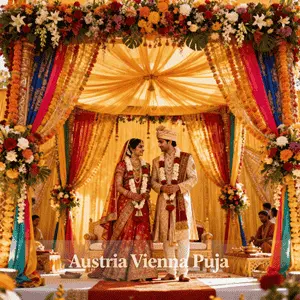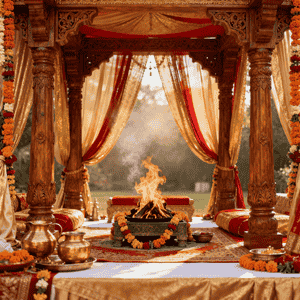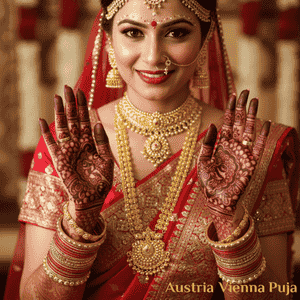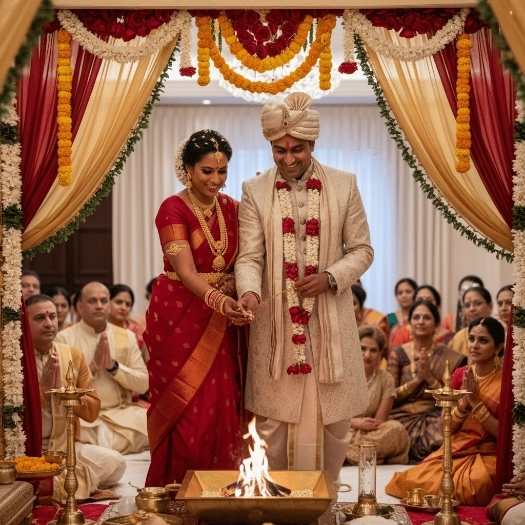


Yatra Praarambha (Begin Your Sacred Journey)

Puja Homam: Sacred Vedic Fire Ritual for Spiritual Transformation.
HOMA
Read Now

Homa Understanding Hindu Puja | Vedic and Tantric Traditions .
PUJA
Read Now

Hindu Wedding Services | Sacred Union Ceremonies.
Hindu Wedding Services
Read Now

Vedic Astrology Services | Cosmic Timing and Spiritual Guidance.
Vedic Astrology Services
Read Now

Vivaah Samskara Sammelan (Authentic Hindu Wedding Ceremonies in Europe)
Hindu culture honors many sacred samskaras (rites of passage) throughout life’s journey. Among these, the Vivaah Samskar—the marriage ceremony—marks one of life’s most significant transitions: from the student phase devoted to learning and self-development, to the household phase dedicated to family, community, and dharma. This stage is revered as the most important in a Hindu’s life. Marriage represents a sacred union between two souls, binding them with mutual support, shared values, and spiritual purpose. Through this bond, couples fulfill their duty to family, society, and the sacred responsibilities that sustain generations.
Ashtam Vivaah Rupa (The Eight Forms of Hindu Marriage)
Hindu dharma recognizes eight distinct ways to solemnize marriage. The highest among these is the Brahma Vivaah—a union blessed by the full consent and active participation of both families. This form transcends the individual couple, integrating two lineages across generations with complete spiritual approval and collective witness. For deeper understanding of these marriage forms, consult the authoritative resource on Hindu Marriage Traditions, which provides comprehensive scholarly information on all eight forms and their spiritual significance.
Vedic Vivaah Rituals ke Mool (Vedic Origins of Hindu Wedding Rituals)
Every Hindu wedding draws its sacred authority from Vedic tradition. The rituals themselves originate from the mythological wedding of Surya (the Sun God’s daughter) with Ashwini Kumar, as recorded in the Rig-Veda. In that celestial ceremony, the Sun God organized a chariot race, offering his daughter in marriage to the victor. After Ashwini Kumar’s triumph, he received the bride in a splendid, divinely-ordained ceremony. Today, Hindus continue these same sacred rituals, chanting mantras directly from the Rig-Veda. Each mantra carries profound spiritual significance and precise ceremonial meaning. These explanations and their deeper implications are preserved in the Grihya Sutras—the authoritative Vedic domestic ritual texts that guide every step of the ceremony. To explore the historical and textual foundations of these practices, the Encyclopedia Britannica: Hinduism offers authoritative insights into Vedic traditions and their contemporary applications. Our experienced Hindu priests in Italy and Santorini are deeply versed in these Grihya Sutras, ensuring every ritual honors both the letter and spirit of Vedic tradition.
Panigrahan (marriage ritual)
This ceremony includes the traditional welcoming of the groom’s family at the wedding venue with sweets and Arati. The ceremony starts with an invocation of Lord Ganesha to seek his blessings and remove all the obstacles in life. The maternal uncle of the bride has a very important role to play in the ceremony. He, along with other members of the family, brings the bride to the marriage ceremony. After the chanting of Vedic mantras, the bride and the groom exchange garlands symbolizing mutual approval to the union. The bride and the groom are now ready to enter into wedlock. The parents of the bride “give away” the Bride into the hands of the groom. Hindus consider this as one the noblest acts one can perform. This is one way of repaying the debt to their ancestors and passing the family heritage to the future generations.
Vivaah Homa (sacred fire ceremony)
Right since the ancient times, every Hindu ceremony involves the presence of fire as one of the main witnesses. The fire symbolizes light, power, and knowledge. The wedding Hindu priest recites the holy mantras confirming the union of the two souls in the presence of fire as a witness. The groom and the bride repeat the sacred pledge and request the fire to act as a messenger to God for hearing their various prayers for Santati (children), Sampatti (wealth), and Deergharogya (long, healthy life).
Laja Homa (offering of rice to the fire)
This starts their transition into the second phase of their lives. The brides’ brothers have an important role to play in this phase of the ceremony. They offer parched rice to her to enable her to offer the same to the sacred fire. Hindu scriptures draw an analogy with the method of planting the rice saplings. Farmers transplant the original rice saplings to another place to facilitate better yield. In the same manner, the bride’s family transplants her to the groom’s family to spread happiness. This is one way of handing over the bride to the groom for future safekeeping.
Ashmarohan (marriage ritual)
The groom adorns the bride’s neck with a mangalsutra (necklace symbolizing the relationship) and apples kumkum (vermillion) on her forehead signifying her status as a Sowbhagyavati (harbinger of good luck). The bride applies tilak (sandalwood mark) on the groom’s forehead signifying his status as a Grihastha (householder) and initiating him into the second phase of his life.
Agni Pradakshina (circumambulation around the sacred fire)
This marks the first steps of the couple into the second phase of their lives. They circle the sacred fire four times with the groom describing their complementary relationship in poetic terms. Once this ritual is over, the bride moves over to the left side of the groom, signifying total transition from one family to another.
Saptapadi (Taking the seven steps)
According to the Grihya Sutras, all Hindu marriages—regardless of geographic region—follow seven essential ceremonial steps known as Saptapadi (the seven steps). These are universal across North and South India, with occasional regional variations that enhance rather than alter their essential meaning. The Saptapadi represents the couple’s first sacred journey together, with each step carrying profound spiritual significance. As the bride and groom take these seven steps around the sacred fire, they make seven sacred vows to each other:
First Step: Signifying mutual provision, nourishment, and support for each other throughout life’s journey.
Second Step: Developing mental, physical, and spiritual strength together as partners in dharma.
Third Step: Sharing worldly possessions, wealth, and prosperity with generosity and equality.
Fourth Step: Acquiring knowledge, happiness, peace, and wisdom through shared learning and spiritual growth.
Fifth Step: Raising strong, healthy, and virtuous children who honor dharma and family values.
Sixth Step: Enjoying the fruits of all seasons—embracing life’s joys and challenges together with equanimity.
Seventh Step: Remaining lifelong friends, companions, and cherishing each other’s lives with unwavering devotion.
Upon completing these seven steps, the couple’s union is considered eternally sealed. As the ancient saying declares: “With these seven steps, you have become my friend. May we walk together for all seven lifetimes.” For comprehensive information on Hindu wedding ceremonies, samskaras, and Vedic rituals, explore Britannica: Samskara which provides authoritative insights into life-cycle rituals and rites of passage in Hindu tradition.
Dhruv Saptarishi Darshan (Integration of the bride into the grooms family)
This is the final phase of the ceremony where the integration of the bride takes place into the groom’s family. They accept her in totality. This changes her gotra (clan). With this, the bride takes the surname of the groom signifying the total integration. In the olden days, the groom used to show the seven-star (Saptarishi) constellation to the bride and seek their blessings. He also points out the Pole Star signifying that their relationship should be as steady as the Pole Star (Dhruv Tara). There are many more ceremonies depending upon the local rituals which are performed by Hindu priest for marriage ceremony . However, the above-mentioned seven rituals are common throughout all Hindu weddings.
There are many post-marriage ceremonies too such as welcoming of the bride into the groom’s household, naming of the bride and so on. This may differ from place to place.
We have seen the background and spiritual significance of a Hindu wedding ceremony.